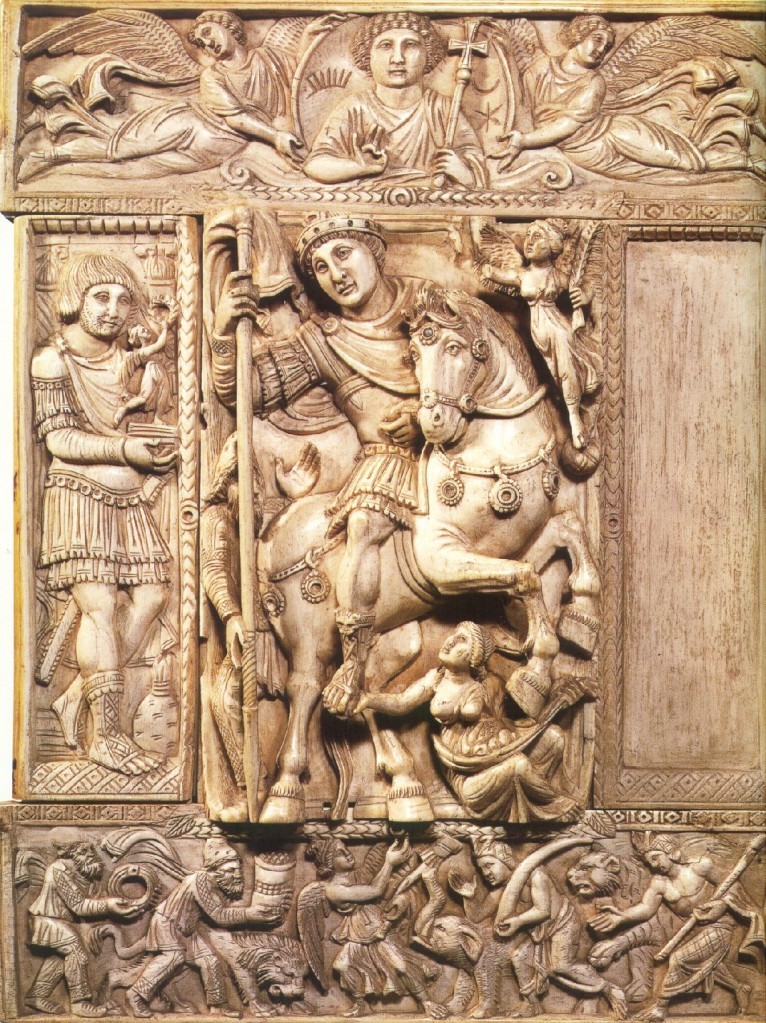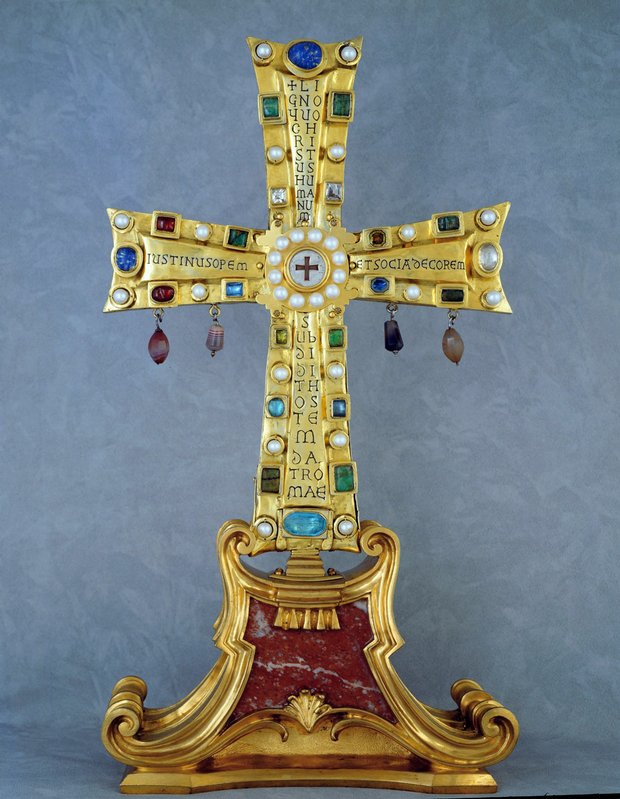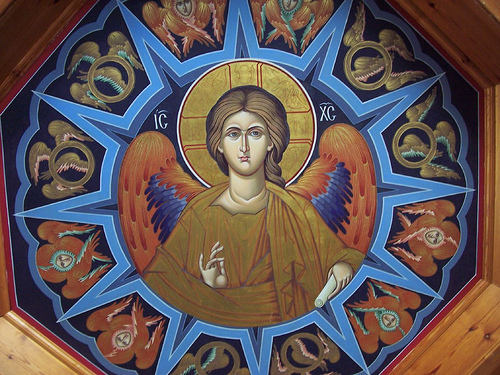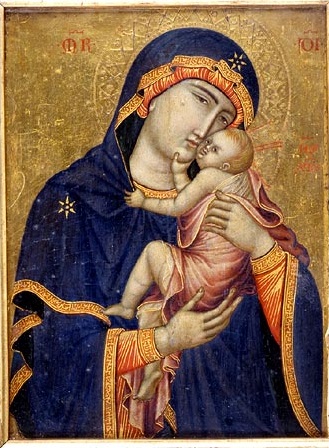”They held in their lifeless hands the riches of their fathers, without inheriting the spirit which had created and improved that sacred patrimony:they read, they praised, they compiled. but their languid souls seemed alike incapable of thought and action. In the revolution of ten centuries, not a single discovery was made to exalt the dignity or promote the happiness of mankind. Not a single idea has been added to the speculative systems of antiquity, and a succession of patient disciples became in their turn dogmatic teachers of the next servile generation. Not a single composition of history, philosophy or literature, has been saved from oblivion by the intrinsic beauties of style or sentiment, of original fancy, or even of successful imitation”. ( Edward Gibbon, The Decline and Fall of the Roman Empire )

The minor arts of Byzantium are notable for their richness of detail, sumptuous materials, and sophisticated craftsmanship. This plaque is part of the so-called Barberini Ivory and shows the Emperor as champion of the Faith. sixth century A.D.
True or False? No abstentions allowed. It would appear that Byzantium has received an historical bad rap that has suggested and implied through a misrepresentation, the later history of Byzantium as a “thousand year history of decline”, leading inevitably to its conquest by the Ottoman Turks on Tuesday 29th May 1453. This perception, promoted disastrously by the English historian Edward Gibbon, reflects the origins in the classical studies of Byzantine studies and has negated their cultural, artistic and architectural contribution and in turns underlines the importance of controlling history.
”The classic periods of ancient cultures [the fifth and fourth centuries BCE in Greece and the late republican/early imperial period in Rome] have long appealed to modern Western sensibilities because – as times of rapid change and innovation in art and literature – echoes and origins of the present have been seen there. In comparison, Byzantine political culture changed slowly, and continuity was valued over change. Furthermore, classical secularism, so attractive to Renaissance and Enlightenment scholars, had no place in Byzantine thought worlds. As a result Byzantine culture was subjected to centuries of abuse as a time of barbarism and superstition.

Restored Cross. A reliquary cross of silver gilt sent to the Vatican by the Emperor Justin II. It encloses a piece of the True Cross and is still carried in Good Friday processions in St. Peter's basilica.
The counterpart to the dismissal of Byzantine culture was its exaltation by 19th-century Romanticism, and by a substrate of Christian, especially Anglican, intellectuals. [Even now Anglican seminaries are good places to locate books on Byzantine studies.] Byzantium was also “claimed” by some Orthodox Christian intellectuals. The result was that, after having been demeaned by the Enlightenment, Byzantium acquired defenders, but defenders who concentrated equally on the culture’s religious aspects. Far from calm scholarship, Byzantine studies has ever been a locus of contestation, of defamers and champions.”
”And therefore I have sailed the seas, and come to the holy city of Byzantium” ( W.B. Yeats ) Byzantium civilization is a major world culture. While few would claim elevated status for much Byzantine literature, in its art and architecture, Byzantine culture was genuinely, and despite itself, innovative and capable of producing works of great beauty, and its study far from the ”ungrateful and melancholy task, and uniform tale of weakness and misery”, that Gibbon claimed.
The importance of the architectural form that the dome assumed in the Byzantine world is not to be underestimated. It was Christ, ”Christos Basileus”, who was the true founder, ruler and consummation of the God-supported and God-protected Christian empire of Byzantium. It was his law, as manifest in the Gospels, that was to provide the pattern for imperial life; his cross was carried at the front of military processions; his image, crowned with the imperial diadem, was tamped on coins; it was in his name that laws were promulgated.
But if Christ was spiritual ruler of Byzantium, his temporal instrument for achieving the corporate salvation of his chosen nation was the Christian emperor. Although formally elected by the Seante and proclaimed by the people and the army, the emperor was in fact regarded as chosen by divine decree and therefore as occupying a position superior to that of other mortals. Temporal representative of Christ, the emperor was equal to the apostles, and the mystical procession of his days as well as the elaborations of court ceremonial were patterned on the example of his celestial paradigm. His costume was like an icon.
At Easter he donned the garb of resurrection, and appeared surrounded by twelve apostles, his body swathed in white bands. Twelve guests sat at his table at meals.His receptions were not so much audiences as epiphanies, divine appearances. Amidst all this gilt and pageantry, and at the center of attention in the Sacred Palace, was the imperial throne in which the sovereign himself, clothed in gold and bathed in sanctity, ruled over all. Sacred to, was all he touched; his garments, his letters, the golden imperial seal. To insult him was to blaspheme. To revolt against his authority was to invite excommunication.
Rebellion was apostasy. And this sanctity of the sovereign flowed over into that of his ministers, and indeed into the whole imperial administration. Entrance into public office was a kind of ordination; to leave it was to lay down a sacred trust. The veneration due to the emperor in this way conferred on the whole imperial service a truly hieratic character; and were the backbone of the state. The combination of highly trained offiicials and military aristocrats all personally known to, chosen by, and directly responsible to the emperor, made the Byzantine administration one of the most centralized and at the same time one of the most efficient of which we have a record.
The spiritual and eternal side of Byzantine life was most fully represented by the monasteries and hermitages.Specifically, the craggy fastness and desert caves of the hermits were the forging houses of what the Byzantines regarded as the highest type of humanity, the types in which the Christian ideal was realized to the fullest possible extent on earth. The emperor might be God’s elect but the saint or the holy man was more; he was a living holocaust of divine energies, the incarnation of the holy spirit, witness of God, and in a certain sense God himself. For the Byzantines saw the highest type of humanity fulfilled not in those who lived a terrestrial life of moral rectitude or judicious piety, but in those who through earnest battle had broken a barrier between man and God, and had fused the two once more into vital conjunction. It was this union that the saint or the holy man had accomplished.
Mortal life was a constant warfare between myriad unseen forces, divine and demoniac, ever-present, overwhelming and unappeasable. The saint or holy man was a mediator between earth and heaven; where else could people turn, but to those who through divine power could subject even the demons to their bidding? Fanatic as though they may often appear; these weather wracked and gaunt men, ascetic warriors, were willing to defend against the rapine and injustice of the powerful, even to the point of bringing an errant sovereign to heel. He had nothing to lose since he had already renounced the world and all its ways. All that could be taken from his was his mortal life, and if he should lose it through violence, he would gain a martyr’s crown and so to become an even stronger focal point of popular worship and superhuman aid than he already was.
The ranks of the monks and nuns furnished the Byzantine period with those heroic men and women who guarded the Empire’s conscience, it spiritual lifeblood. Through them the springs of its inspiration flowed and, barren though it may seem to say it in an age of disbelief, to them was Byzantium chiefly indebted for all that was most vital in her achievement.





 COMMENTS
COMMENTS